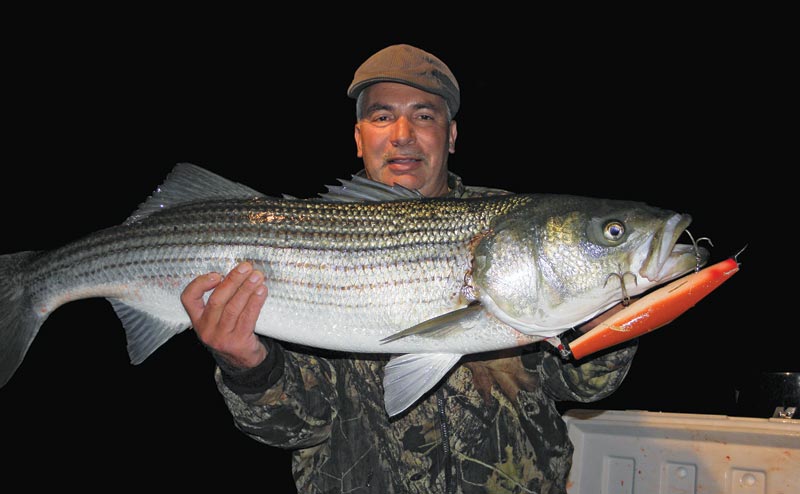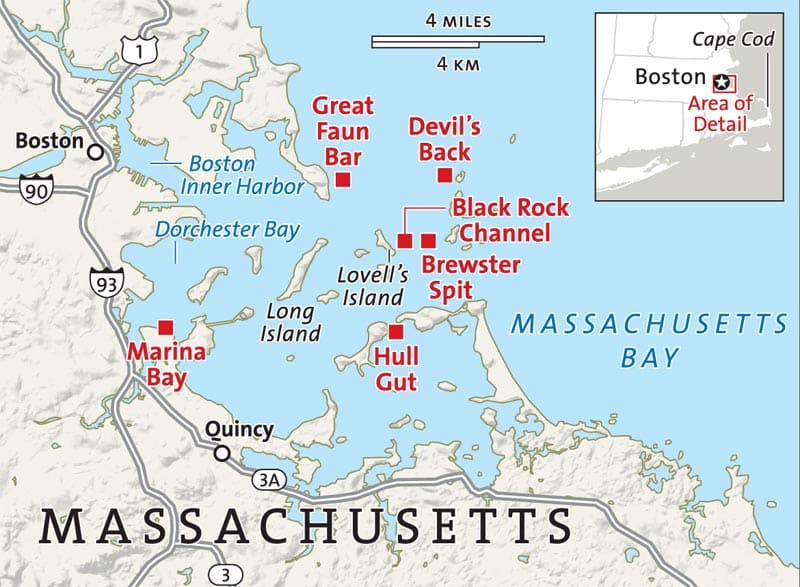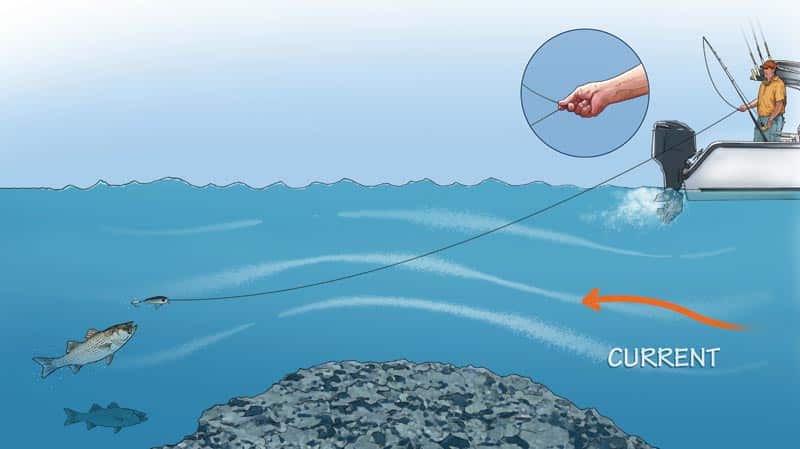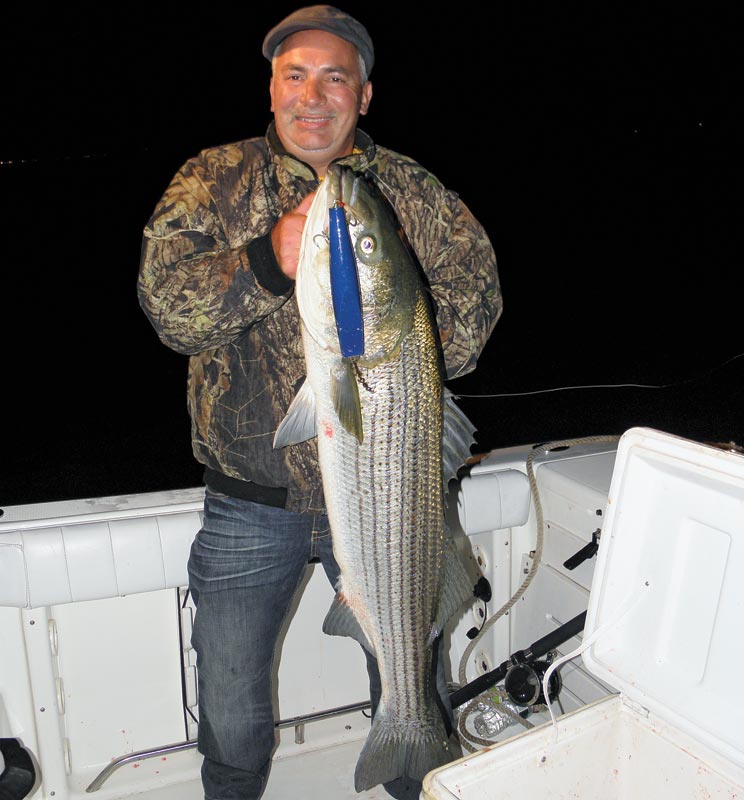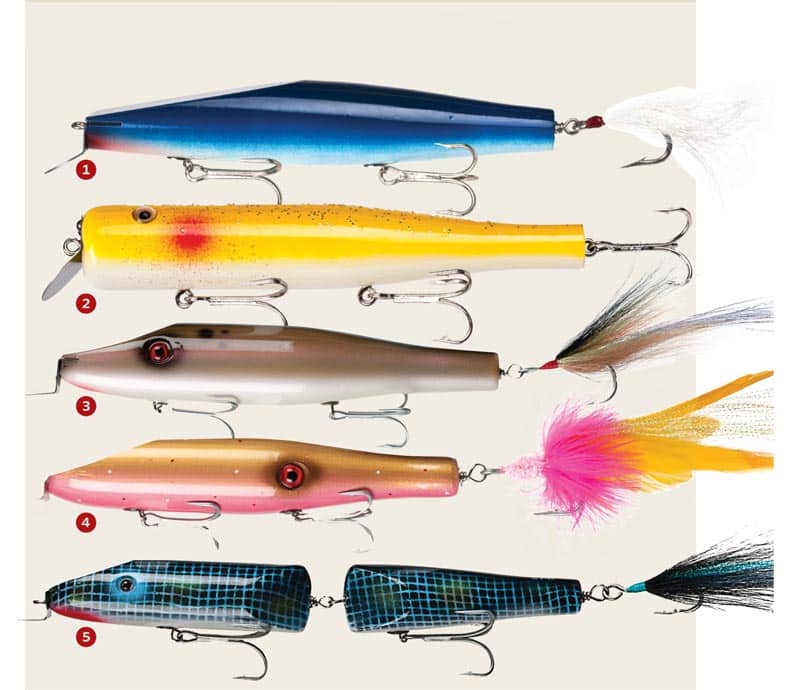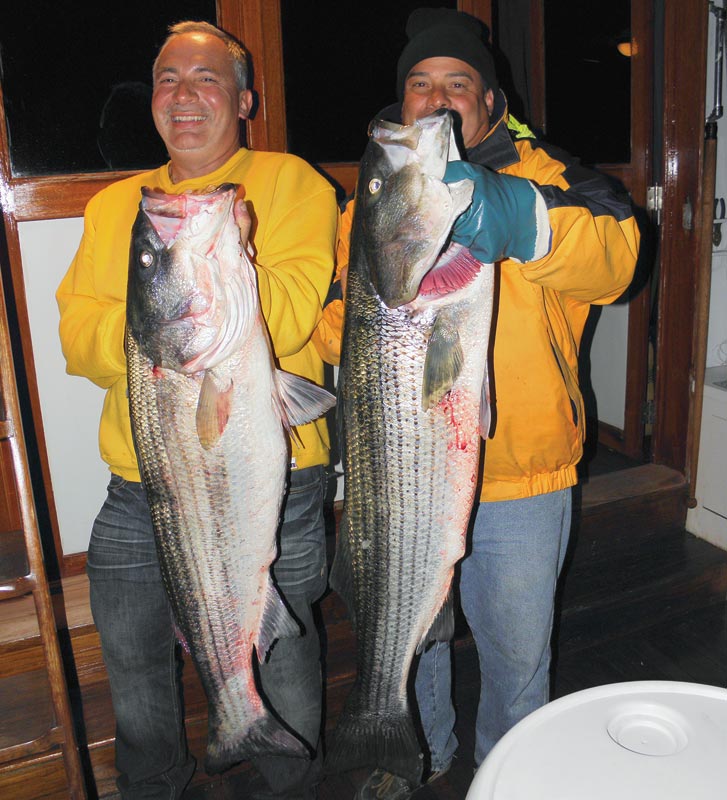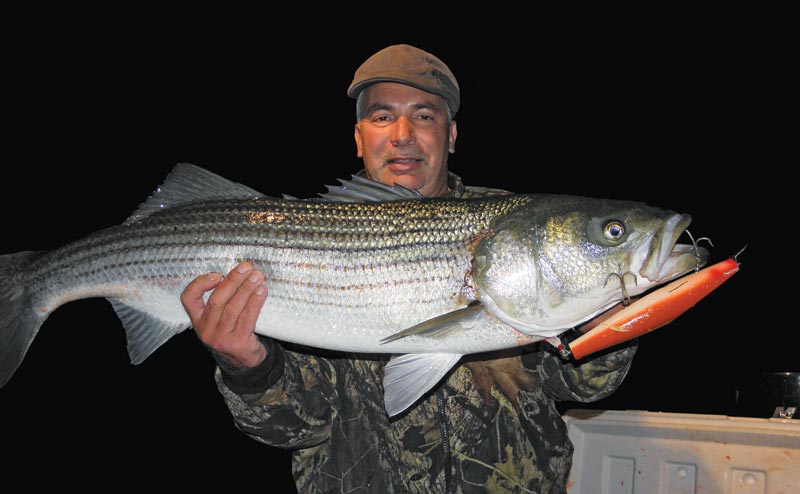
Boston Night Stripers
It’s 1:30 in the morning, dark and damp, and the water streaming by the boat is the blackest of black. I feel like I’m in a fishbowl filled with ink, with twinkling and glowing light all around on the horizon. I find myself wondering whether I’d ever be found if I fell overboard. How far would the current take me? Could I make it to land?
I never get to contemplate the answers. The rod in the port holder bucks over violently and holds steady as 50-pound mono leaves the reel in reluctant bursts. I grab the rod and hang on as Capt. Russ Burgess pulls the 25-foot Triton out of gear and switches on the overhead light. Now I can see the faint outline of my line, which disappears into the darkness astern.
“Good one?” asks Pete Santini as he furiously cranks in the second line, being careful to slow his retrieve at the end so the plug won’t fly out of the water and rocket into the cockpit. I grunt a response meant to be positive and slowly work the fish in. Suddenly the rod begins to relax, and I’m not sure why. I stop reeling. “No, no, keep winding,” implores Burgess. “It’s coming at us with the current.” I reel as fast as I can, and the rod slowly bows over again.
Shortly a greenish-white glow appears at the edge of the light. It’s a striper, and a beauty. Santini grabs the gaff, neatly sticks the fish and swings it aboard. It thumps on deck. Santini twists the 10-inch plug out of its jaw and slides the bass into a giant Igloo cooler. “About 25 pounds,” he announces. Burgess shifts the 200-horsepower outboard back into gear, switches off the light and lets his lure back in the wake. Seconds after he flips the lever on the reel, his rod arcs over. Out of gear, light on. Burgess leans into the fish and cranks. Santini picks up the gaff. The drill would be repeated six more times in the next two hours.
**
Old Becomes New**
I’ve fished for striped bass for over 50 years, but this was all brand-new to me. Trolling the rips of Boston Harbor in the dark with huge wooden “baseball bat” plugs wasn’t anything I ever thought I’d be doing, but it was just another night out for Burgess.
“I started trolling off Cuttyhunk back in the 1970s, when I was a teenager,” he explains. “The late Bill Goglia of Bristol, Rhode Island, taught me how to do it. Back then we used big Danny plugs and Goo-Goo Eyes. Later I began fishing Boston Harbor at night. There were a few guys using big plugs, but they anchored up and just let the lures back into the current. You can still do that and catch big fish, especially when there are a lot of them around, but trolling is far more productive. The flip side is that there are hundreds of rocks and ledges just waiting to destroy your lower unit, so you have to be really careful.”
The 50-pound conventional tackle is pretty straightforward, but the oversize, metal-lip swimming plugs are the key to taking huge stripers. “The big Danny Deep Diver, made by Gibbs Lures, has been the most consistent producer for me,” says Burgess. “It comes in white, black, yellow and blue. I don’t find that color makes much difference, although I do like bucktail on the rear hook. The main thing is that the plug has to swim right. After it has caught a bunch of fish and gets beat up, it won’t. That’s when I tie on a new one, since these lures perform best right out of the box. I go through hundreds of plugs a season.”
You can simply let the lure back 100 feet and stick the rod in a holder, but Burgess has a special technique he learned at Cuttyhunk that works far better:“I put the rod in a holder amidships and hold the line in my fingers. That way I can tell if the plug is swimming right. If it picks up the tiniest bit of weed, I’ll know it. And when a fish hits, I set the hook by hand. I can tell the size of the fish that way too.”
We fished just one rip that night, but Burgess says there are plenty of productive rips all through Boston Harbor, and he doesn’t mind sharing information. “Good rips include the Devil’s Back, but you need to troll around it, not through it, because of the rocks,” he explains. “The rip at Black Rock Channel off Lovell’s Island is a good one because it’s deep and you can troll through it. The rip at Great Faun Bar is also productive, as is the one at the northeast side of Long Island, New York. I catch bass in the rip just inside Hull Gut and on the Brewster Spit, which runs from Boston Light to Lovell’s Island, but a lot of that’s uncovered at low water.”
Burgess says that most good bass rips, which form over submerged structure or an abrupt change in depth during a running tide, range from 12 to 20 feet deep. “The plugs run about 14 feet down at 112 knots,” he says. “If there are a lot of fish around, it doesn’t matter whether you troll with the current, against it or across it. But when the action is slower, it’s almost always better to troll against it.”
As for tides, Burgess says that some rips make up on the incoming, others on the outgoing. The Long Island rip, for example, forms on the outgoing. “Rips produce best when the tide is running well,” he says. “But the stage of the tide is really secondary to darkness. You might catch a bass on one of these plugs in daytime, but I wouldn’t bet on it. It’s got to be at least dusk when you start trolling.”
How well do baseball-bat plugs produce? Trolling just two lines, we ended up with six keepers that ran from 12 to 35 pounds, plus two big bluefish that crashed the party, before we headed back to Quincy’s Marina Bay. “This wasn’t a real big night,” admitted Burgess, who puts in about 120 trips a season and normally catches well over 1,000 keeper bass, sometimes as many as 40 a trip.
“The average size is probably 25 to 30 pounds,” says Santini, owner of the popular Fishing Finatics tackle shop in nearby Everett, who routinely fishes with Burgess. “Burgess usually catches four to eight fish over 50 pounds per year, a dozen or so over 45, and a whole pile over 40. His technique is just plain deadly on big bass. You’re much more likely to catch a 30-pounder than a 10-pounder.”
Burgess believes that night-trolling big wooden plugs will work anywhere in the Northeast where there are structure-formed rips that hold stripers. “Best bet is to scout out a rip at low water in daylight before heading out at night,” he advises. “It sure isn’t the easiest or most convenient way to fish, but once you figure out a rip, you’ll be rewarded with some truly big bass. For me, that’s what it’s all about.”
Trip Planner
Although Burgess’ go-to plug is the venerable Gibbs Danny Deep Diver, which has an 8-inch body and is some 12 inches overall, he’s also had great luck with some handmade creations crafted by Gary Soldati of West Stockbridge, Massachusetts, who formed a company called Big Water Lures back in 2006. “As a surf-caster, I fished eels for years, then started using plugs,” says Soldati. “I wanted bigger plugs than most that were on the market, so I figured I’d have to make them myself.”
Soldati’s plugs are true works of art, with a glasslike finish second to none, and he custom-makes all his stainless-steel lips. Prices, which range from $30 to $45, reflect the amount of time it takes to handcraft each lure. “Burgess caught over 60 big bass in two consecutive nights on an 8-inch Giant Pike in 2010,” says Soldati.
The Troller, with a 10-inch body and a weight of 712 ounces, comes in five colors and is ideal for night trolling, as it runs 15 feet deep. The super-long Jointed Eel, with an 11-inch body, looks to be another hot bat in the lineup.
For complete information on Big Water lures, check out www.bigwaterlures.com. For information on Stan Gibbs’ Danny plugs and other models, visit www.stangibbslures.com.
Rods: 6-foot medium-action trolling rods.
Reels: 4/0-size level-wind, star-drag or lever-drag.
Lines: 50-pound mono.
Leaders: No leader. Attach the lure directly to the line with a large snap swivel.
Lures: Gibbs Danny Deep Diver 1 and Goo-Goo Eyes Big Daddy 2; Big Water Lures Troller Bunker 3, Giant Pikie in Squid 4 and Jointed Eel 5.
What: Season-long striped bass fishing.
When: Mid-May through mid-October.
Where: Boston Harbor, Massachusetts.
Who: Boston Harbor has a number of launch ramps, with distances to the rips ranging from a mile or two to 10 or more, depending on point of embarkation. For a free copy of the 2011 Massachusetts Saltwater Recreational Fishing Guide, which lists launch facilities in the Boston area, regulations and more, call 617-626-1520 or e-mail your request to marine-fish@state.ma.us. There’s also lots of good information at www.mass.gov/dfwele/dmf/recreationalfishing/saltguid.htm. To set up a trip with Capt. Russ Burgess, contact:
Capt. Russ Burgess
617-224-2368
www.fishinboston.com
Pete Santini
Fishing Finatics tackle shop
617-381-1997
petesantini@yahoo.com
www.santinitube.com
